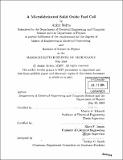A microfabricated solid oxide fuel cell
Author(s)
Mehta, Ankur, 1983-
DownloadFull printable version (7.529Mb)
Other Contributors
Massachusetts Institute of Technology. Dept. of Electrical Engineering and Computer Science.
Advisor
Martin A. Schmidt and Klavs F. Jensen.
Terms of use
Metadata
Show full item recordAbstract
With the ever-increasing ubiquity of mobile consumer electronic devices comes the rising demand for portable electric power. Current battery technology gives a very modest energy return per weight or volume. Hydrocarbons have a significantly higher energy density, and so fuel conversion systems only need to have several percent efficiency to match and surpass the specific energy of conventional batteries. Thus, there is a strong market for successful portable fuel powered electric generators. The goal of this thesis is to investigate the design of one such device, a two-chamber microfabricated solid oxide fuel cell (SOFC). This device produces electric current through the electrochemical oxidation of fuel through an ionic conductor. Oxide ions permeate across a ceramic electrolyte membrane to react with the fuel, driving electrons back around through the load. The focus of this work is to analyze the behavior of these membranes to prevent failure as the device is heated to its operating temperature near 800K. Experiments and analysis of free-standing electrolyte membranes indicate that failure is unavoidable over the required temperature range, and so supported structures are investigated. The results of experiments with a perforated nitride supported membrane presented herein indicate the need for a more thorough understanding of the thin film stresses responsible for membrane failure, as well as careful support structures to accommodate these. Designs for future devices are presented to improve stability and move closer to a final complete portable power system.
Description
Thesis (M. Eng.)--Massachusetts Institute of Technology, Dept. of Electrical Engineering and Computer Science; and, (S.B.)--Massachusetts Institute of Technology, Dept. of Physics, 2004. Includes bibliographical references (p. 83-85).
Date issued
2004Department
Massachusetts Institute of Technology. Department of Electrical Engineering and Computer Science; Massachusetts Institute of Technology. Department of PhysicsPublisher
Massachusetts Institute of Technology
Keywords
Physics., Electrical Engineering and Computer Science.